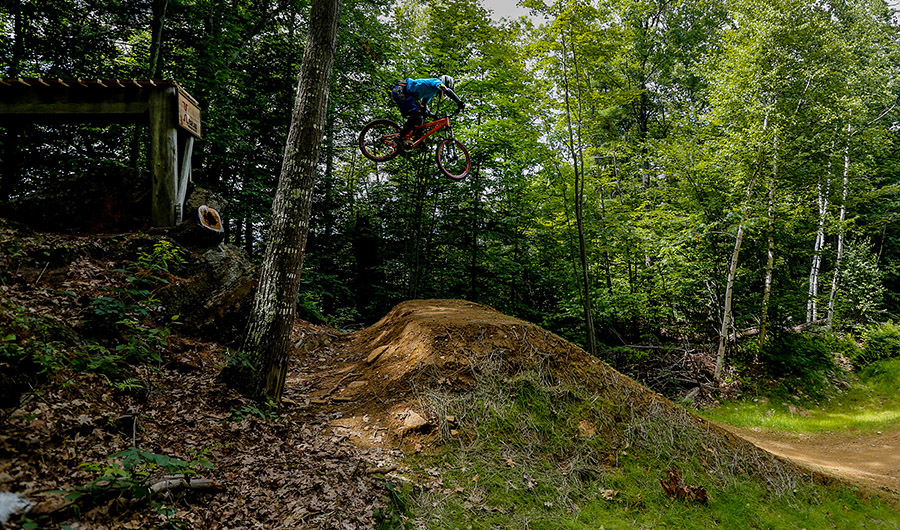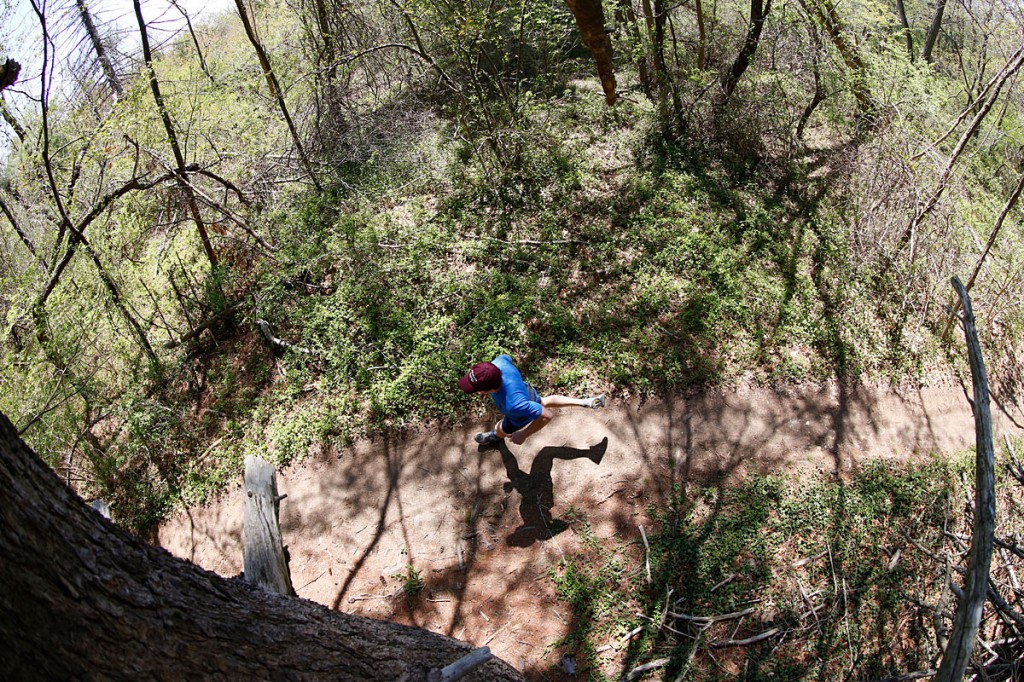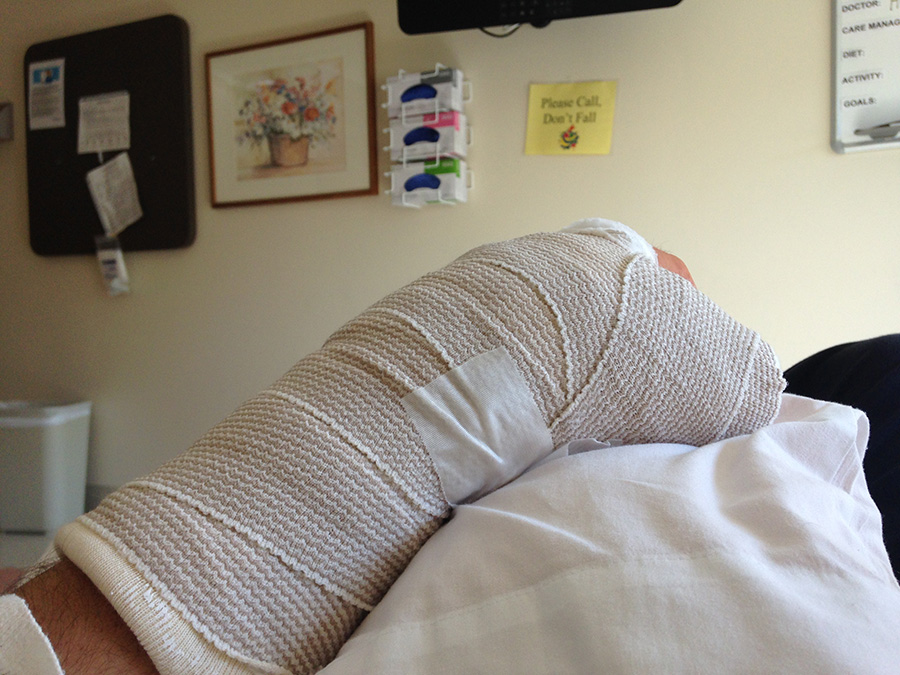I remember the nurse putting the IV port in, and my poor attempt at a joke about climber veins. It probably wasn’t that good, but it was a veil for my nervousness, albeit as transparent as the fluid flowing into my arm. The only other time I had been under a general anesthetic was as a high-school punk waiting to have my wisdom teeth yanked – the only repercussions of which I would have faced were abstaining from certain activities familiar to ill-behaved teenage punks. This time I had a lot more on my mind.
_______________________________________________________________________________________________
It was a perfect forecast, the kind of which inspires hard-working honest stiffs to tuck their morals in their back pocket, call in sick, and peel back the sun-beached cover from their floating home-equity loans. I don’t have a boat, so second best would be my opening day at a nearby mountain on my freshly-tuned DH bike.
A crisp breeze kept the sweat down and the blackflies at bay; lift-lines were non-existent and the runs were dry but not dusty. Over the winter I trained a bit, tuned up the bike, and – y’all can see where this is headed, right?

It wasn’t a huge drop, maybe 12-15 feet, but I came in like last year’s prom king: hot, rusty, and way over-confident. At first it was all treetops, but by the time the wooden-ladder bridge pitched down I realized I was about to overshoot the landing significantly, and it’d be bad. And it was.
Anyone who’s crashed knows the immediate (assuming consciousness) inventory of body systems. Can I see? Check. Breathing ok? Check? Blood? Negative. Move limbs? Check. Teeth in place? Check. Crushing pain? Nope.
By the time I got to scanning my extremities, it didn’t take me long to realize that something was very wrong. My right hand went to feel my left, which resembled partially a frozen claw. I ripped off the left glove, exposing a mannequin hand where my own should have been: my thumb horribly displaced and sticking out at a nauseating angle.
I gave a quick check for distal circulation/sensation, was mildly comforted I probably wouldn’t lose the thumb, then tried to reduce the freak appendage. I closed my eyes, clenched my teeth, and wrenched on the thumb trying to return it to a natural position. Once, twice, and no movement. Well son, you just earned a free trip to the hospital.
Over two hospitals (one local and a trauma center) I became known as “the guy with the thumb,” and a party trick in the ER(s). Seemed like every doc, nurse, and PA who heard about my case wanted a crack at manual reduction, as if my palm was the stone and they all wanted to be proclaimed “King of the ER” by jockeying it back in place. Well no kings were to be crowned this day, at least not until Sir Surgeon and his wizard anesthesiologist came riding through Camelot…
_______________________________________________________________________________________________
You never realize how important thumbs are until one is gone. Things like buttoning shirts, putting toothpaste on a toothbrush, and unscrewing a jar of peanut butter become maddening tasks worthy of toddler tantrums. I might just have thrown more than one (see my future entry The PB Diaries).
Injuries are added to the cost of admission for sports, and, well, you gotta pay the piper once in a while. Call it paying your dues, or perhaps the universe’s way of saying “slow the hell down.” In any case, the risk of being temporarily sidelined in my opinion is still better than being a spectator.
The hardest part, the physical therapy appointments that made me nauseous with pain withstanding, is sitting out the recovery. Suddenly more picture-perfect days appear, your phone is blowing up with out-of-town athletes passing through and asking you to meet up and climb, and you’ve got nothing to do but sit and soak – twice a day in hot water before home therapy exercises.
So how to keep sane through all this?

1 – Train. Hard. Trailruns with killer hill repeats. Ab workouts to make you want to puke. “Epic deathmarches” as a good friend put it. Anything and everything to let your burn off some steam while keeping the extremity safe.
2 – Rehab hard. Commit to PT exercises and at-home torture sessions. Motivation needs a kick in the ass sometimes – thoughts of your longstanding climbing project or personal PR on the horizon can be just the trick. I engineered tiny PT workout tools, re-created from my PT’s office, and installed them everywhere from my car to my desk. I’m still finding putty balls and busted rubberbands under the couch.
3 – Projects. I keep a folder of photo ideas on my desktop, and being injured gave me an excuse to get to work on longstanding shots I wanted to try out.
4 – Make plans. Once my left thumb was able to handle a keyboard, I started searching out beta on future trips. Staying stoked is important to keep your brain from imploding into a spiral of despair. Norway anyone?
5 – Do stuff you still can. I was always up on the fact that I was never bored, and with the injury this murky beast would come creeping, wearing a grin of schadenfreude. At times I had to force myself to crack open old books, or practice tying obscure climbing knots. I dusted off old skills, and wouldn’t dwell on the stuff I couldn’t do.
6 – Rest. A lot. Chances are if you’re reading this you run yourself pretty hard throughout the year. A few weekends of sleeping in and rest will go a long way towards refreshing the body for when you’re ready. Visit family, catch up on work. If you can stomach the time off it’ll do you nothing but good, providing of course it isn’t a gateway to opioid abuse.
7 – Try something new. No, not a new Netflix stream. Something productive, that’ll add to your character. Think cooking or meditation, stuff you’d never try when preoccupied with your usual schedule. It’s a deep pit to define ourselves by what our pursuits are, and situations of rehab are chances to prove we’re more than just our hobbies (or work, or talents even).
8 – Mentally train. While I’m a big proponent for studying schools like NLP, Shambala, The Fourth Way, and Warrior Craft, I’m going a bit more literal here. If you’re an injured swimmer, as torturous as it is, go to a meet and study their strides. Notice the effects of what the swimmers do wrong and right. MTB racer? Download vids of the Worlds and pay attention to the nuances of how the pros flow. You’ll probably learn a thing or two and be stoked again when you can return to play.
I’m almost there myself, soon enough I’ll be back out there playing hard. I just hope my dues are paid up for a while, at least through winter season…
Chris Vultaggio is a Mountainsmith Ambassador and a regular contributor to the Mountainsmith blog.
Follow Chris

Chris, thanks for writing this. I really enjoyed this read and will take some of this advice to heart 🙂